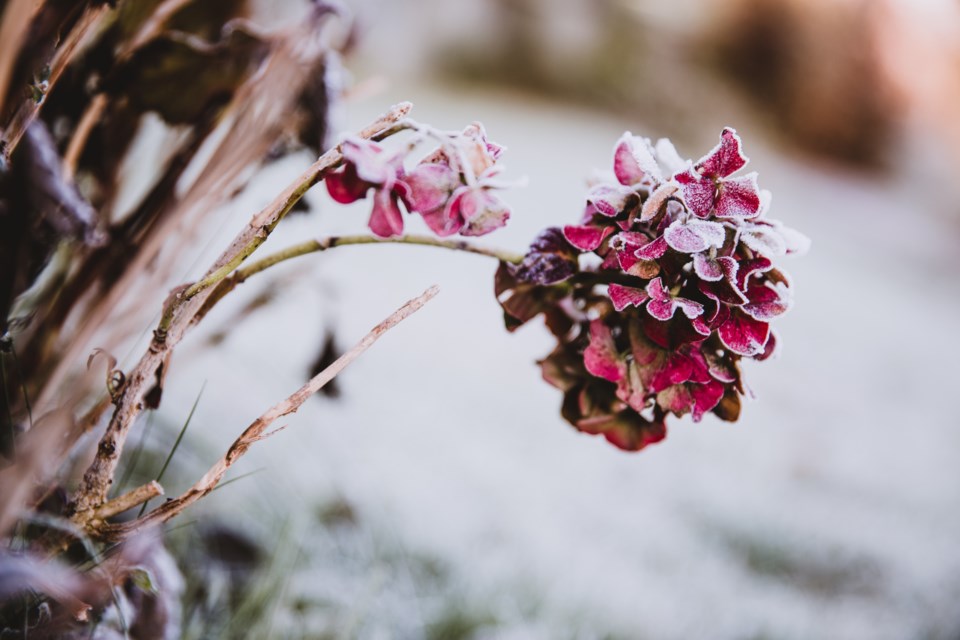The following column was submitted to the Tri-City News from Brian Minter — master gardener, best-selling author, Order of Canada recipient and co-owner of Minter Country Garden Store.
Unfortunately, we have an Arctic outflow on the way.
The good news is we still have time to take some steps to minimize the affects on our plants.
The first suggestion I would like to make pertains to hardiness.
Most of us know what hardiness zone we live in and should, therefore, be planting only those plants that will tolerate our zone.
As a rule of thumb, most of the plants zoned for your region will take the worst most winters have to offer.
Greater Vancouver is generally rated zone 7 and 8, and as you move east through the Valley, zone 6 is the norm.
All plants rated zone 6 or lower should be fine, but with outflow winds, broadleaved evergreens, like camellias, may need a little screening or wrapping.
Some techniques can add a few degrees of protection to many plants.
One thing I noticed several years ago, after an early November cold spell, was that plants growing in very well-drained, sandy soil survived the cold with the least amount of damage.
It seems that if a plant's roots have had to work harder for moisture and food, the plant is tougher and stops growing earlier in the fall.
A good mulching with fine fir or hemlock bark mulch will further protect more tender plants. Mulching makes an incredible difference both in summer and winter. It not only protects from the cold, but it also helps retain critical moisture necessary at both times of the year. It can also be worked into your soils for more porosity.
Immediately after a cold spell, when the temperature is on the rise and the frost is coming out of the ground, it's essential to get moisture back into our plants, especially for those planted under eaves. Soak the living daylights out of the foliage of broad-leaved plants and thoroughly penetrate their root systems with water. Rehydration can really make a difference, saving buds on camellias and rhododendrons, as well as keeping the foliage looking good.
Desiccation caused by cold, drying winter winds is another major problem. As if the severe wind on our more tender broadleaved plants, like aucubas, photinias, and some rhododendrons, is not bad enough, winter sunshine can burn their foliage. Not only is it important to create wind breaks around softer plants, but it's also essential to keep winter sunshine off them during severe cold.
Another important thing for plants exposed to cold outflow winds is to create a tripod of strong stakes and wrap the plants with the new insulating cloth, ‘N-Sulate’, which can provide a 10°C difference in cold protection.
If we experience heavy, wet snow, particularly on hedging cedars and broadleaved plants that tend to hold snow, please remove it by going under the branches with a broom and gently shaking off as much as you can to reduce the weight. On the other hand, snow can be a great insulator, so for most plants it protects and insulates.
It is also important to check bulbs and roots stored in garages and sheds to make sure they are insulated from severe cold and freezing. Small greenhouses are wonderful for starting new plants and keeping over old ones, but plastic and glass are very susceptible to cold.
Greenhouses need to be not only heated but also insulated with bubble poly on the inside to help alleviate the severity of the cold. Wet, heavy snow can break and bend many weaker plants, so staking them and wrapping them tightly with twine for extra support will make a huge difference.
Experiencing numerous years of cold winters has taught us many good lessons. First and foremost, never let your guard down. A couple years of mild winters can lull us into winter complacency. Make sure you always prepare the appropriate winter protection. Cold winters are just a part of the gardening cycle.




